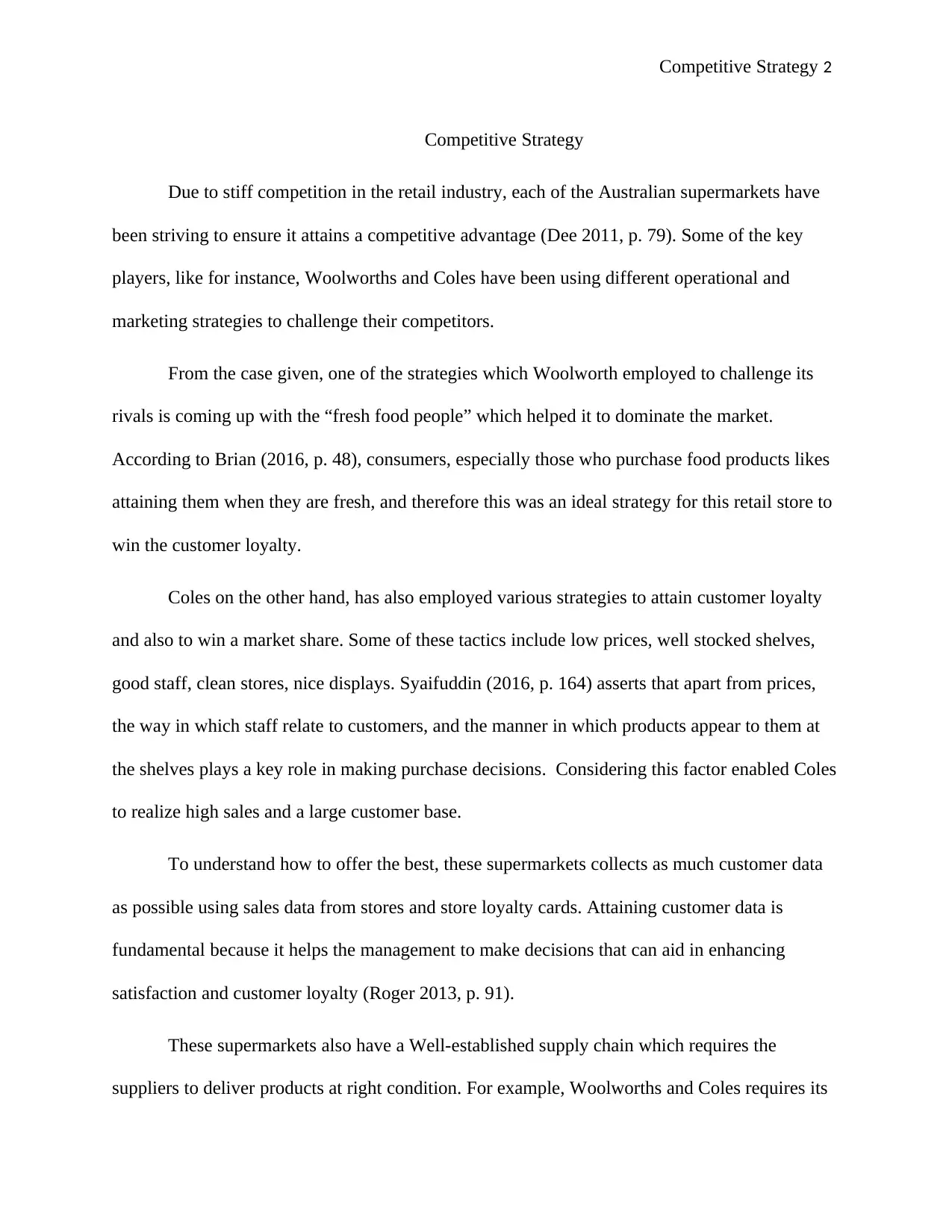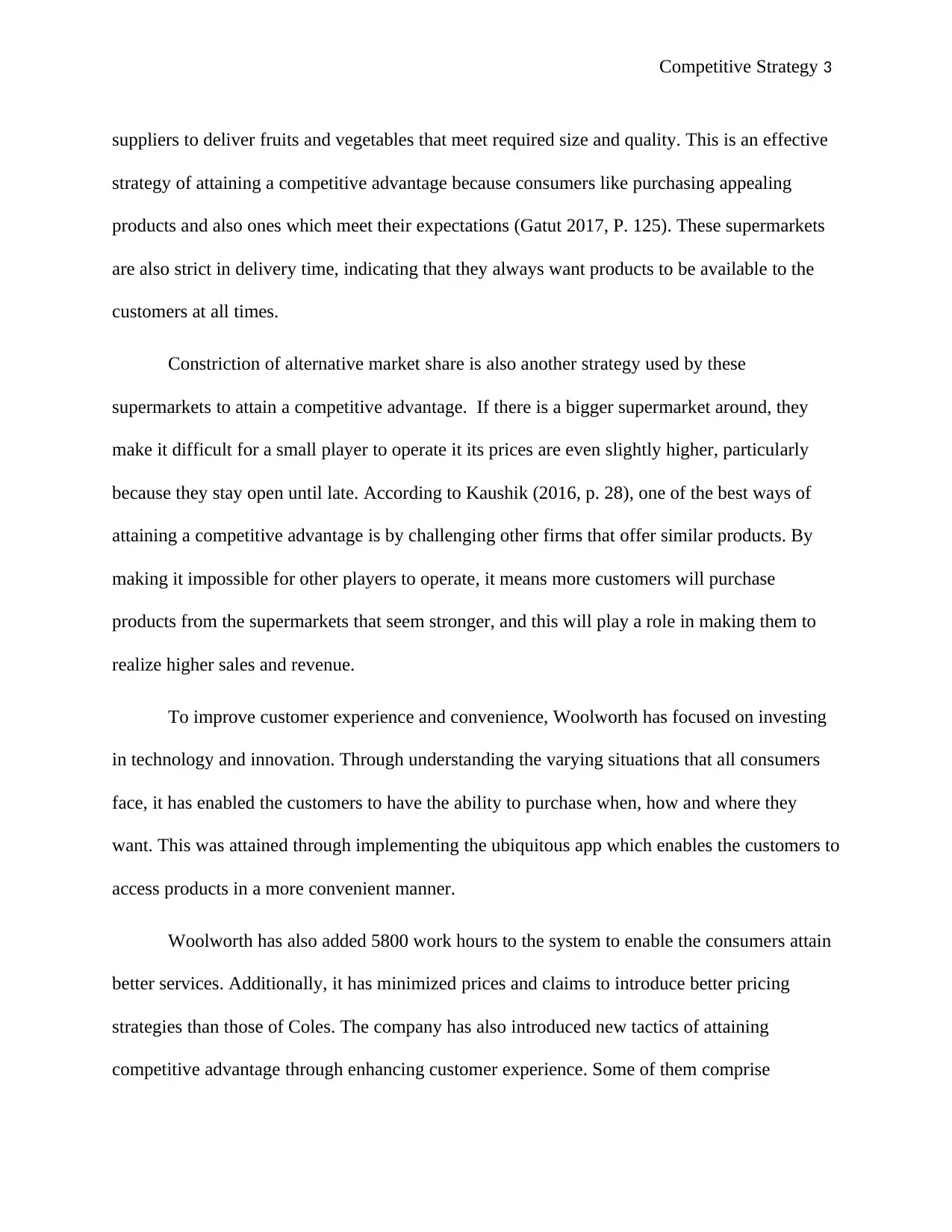HI6006 - Competitive Strategy Analysis of Australian Supermarkets
VerifiedAdded on 2023/06/11
|5
|975
|290
Report
AI Summary
This report analyzes the competitive strategies employed by Australian supermarkets, focusing on Woolworths and Coles. Both supermarkets utilize various operational and marketing strategies to gain a competitive advantage, including customer loyalty programs, data collection, and supply chain management. Woolworths' "fresh food people" campaign and Coles' emphasis on low prices, well-stocked shelves, and customer service are highlighted. The report also discusses the importance of technology and innovation in improving customer experience, as well as strategies for constricting alternative market share. Both supermarkets are focused on understanding customers better and adapting to the digital world through apps and online services. This analysis provides insights into the competitive dynamics of the Australian supermarket industry.

Competitive Strategy 1
Competitive Strategy
by [Name]
Course
Professor’s Name
Institution
Location of Institution
Date
Competitive Strategy
by [Name]
Course
Professor’s Name
Institution
Location of Institution
Date
Paraphrase This Document
Need a fresh take? Get an instant paraphrase of this document with our AI Paraphraser

Competitive Strategy 2
Competitive Strategy
Due to stiff competition in the retail industry, each of the Australian supermarkets have
been striving to ensure it attains a competitive advantage (Dee 2011, p. 79). Some of the key
players, like for instance, Woolworths and Coles have been using different operational and
marketing strategies to challenge their competitors.
From the case given, one of the strategies which Woolworth employed to challenge its
rivals is coming up with the “fresh food people” which helped it to dominate the market.
According to Brian (2016, p. 48), consumers, especially those who purchase food products likes
attaining them when they are fresh, and therefore this was an ideal strategy for this retail store to
win the customer loyalty.
Coles on the other hand, has also employed various strategies to attain customer loyalty
and also to win a market share. Some of these tactics include low prices, well stocked shelves,
good staff, clean stores, nice displays. Syaifuddin (2016, p. 164) asserts that apart from prices,
the way in which staff relate to customers, and the manner in which products appear to them at
the shelves plays a key role in making purchase decisions. Considering this factor enabled Coles
to realize high sales and a large customer base.
To understand how to offer the best, these supermarkets collects as much customer data
as possible using sales data from stores and store loyalty cards. Attaining customer data is
fundamental because it helps the management to make decisions that can aid in enhancing
satisfaction and customer loyalty (Roger 2013, p. 91).
These supermarkets also have a Well-established supply chain which requires the
suppliers to deliver products at right condition. For example, Woolworths and Coles requires its
Competitive Strategy
Due to stiff competition in the retail industry, each of the Australian supermarkets have
been striving to ensure it attains a competitive advantage (Dee 2011, p. 79). Some of the key
players, like for instance, Woolworths and Coles have been using different operational and
marketing strategies to challenge their competitors.
From the case given, one of the strategies which Woolworth employed to challenge its
rivals is coming up with the “fresh food people” which helped it to dominate the market.
According to Brian (2016, p. 48), consumers, especially those who purchase food products likes
attaining them when they are fresh, and therefore this was an ideal strategy for this retail store to
win the customer loyalty.
Coles on the other hand, has also employed various strategies to attain customer loyalty
and also to win a market share. Some of these tactics include low prices, well stocked shelves,
good staff, clean stores, nice displays. Syaifuddin (2016, p. 164) asserts that apart from prices,
the way in which staff relate to customers, and the manner in which products appear to them at
the shelves plays a key role in making purchase decisions. Considering this factor enabled Coles
to realize high sales and a large customer base.
To understand how to offer the best, these supermarkets collects as much customer data
as possible using sales data from stores and store loyalty cards. Attaining customer data is
fundamental because it helps the management to make decisions that can aid in enhancing
satisfaction and customer loyalty (Roger 2013, p. 91).
These supermarkets also have a Well-established supply chain which requires the
suppliers to deliver products at right condition. For example, Woolworths and Coles requires its

Competitive Strategy 3
suppliers to deliver fruits and vegetables that meet required size and quality. This is an effective
strategy of attaining a competitive advantage because consumers like purchasing appealing
products and also ones which meet their expectations (Gatut 2017, P. 125). These supermarkets
are also strict in delivery time, indicating that they always want products to be available to the
customers at all times.
Constriction of alternative market share is also another strategy used by these
supermarkets to attain a competitive advantage. If there is a bigger supermarket around, they
make it difficult for a small player to operate it its prices are even slightly higher, particularly
because they stay open until late. According to Kaushik (2016, p. 28), one of the best ways of
attaining a competitive advantage is by challenging other firms that offer similar products. By
making it impossible for other players to operate, it means more customers will purchase
products from the supermarkets that seem stronger, and this will play a role in making them to
realize higher sales and revenue.
To improve customer experience and convenience, Woolworth has focused on investing
in technology and innovation. Through understanding the varying situations that all consumers
face, it has enabled the customers to have the ability to purchase when, how and where they
want. This was attained through implementing the ubiquitous app which enables the customers to
access products in a more convenient manner.
Woolworth has also added 5800 work hours to the system to enable the consumers attain
better services. Additionally, it has minimized prices and claims to introduce better pricing
strategies than those of Coles. The company has also introduced new tactics of attaining
competitive advantage through enhancing customer experience. Some of them comprise
suppliers to deliver fruits and vegetables that meet required size and quality. This is an effective
strategy of attaining a competitive advantage because consumers like purchasing appealing
products and also ones which meet their expectations (Gatut 2017, P. 125). These supermarkets
are also strict in delivery time, indicating that they always want products to be available to the
customers at all times.
Constriction of alternative market share is also another strategy used by these
supermarkets to attain a competitive advantage. If there is a bigger supermarket around, they
make it difficult for a small player to operate it its prices are even slightly higher, particularly
because they stay open until late. According to Kaushik (2016, p. 28), one of the best ways of
attaining a competitive advantage is by challenging other firms that offer similar products. By
making it impossible for other players to operate, it means more customers will purchase
products from the supermarkets that seem stronger, and this will play a role in making them to
realize higher sales and revenue.
To improve customer experience and convenience, Woolworth has focused on investing
in technology and innovation. Through understanding the varying situations that all consumers
face, it has enabled the customers to have the ability to purchase when, how and where they
want. This was attained through implementing the ubiquitous app which enables the customers to
access products in a more convenient manner.
Woolworth has also added 5800 work hours to the system to enable the consumers attain
better services. Additionally, it has minimized prices and claims to introduce better pricing
strategies than those of Coles. The company has also introduced new tactics of attaining
competitive advantage through enhancing customer experience. Some of them comprise
⊘ This is a preview!⊘
Do you want full access?
Subscribe today to unlock all pages.

Trusted by 1+ million students worldwide

Competitive Strategy 4
introducing more staff service, better trolleys, and better bag sizes for groceries at the self-
checking areas among others.
Just like Woolworths, Coles has also been seeking to understand customers better, and is
striving to expand convenience-style stores. The company also understands that for it to attain a
competitive advantage, it must sell its products at reasonable prices. Therefore, it has been
lowering the prices and plans to continue putting them low in the coming years. It also focuses
on enhancing the customer buying expirince through embracing the digital world through the use
of Coles app.
introducing more staff service, better trolleys, and better bag sizes for groceries at the self-
checking areas among others.
Just like Woolworths, Coles has also been seeking to understand customers better, and is
striving to expand convenience-style stores. The company also understands that for it to attain a
competitive advantage, it must sell its products at reasonable prices. Therefore, it has been
lowering the prices and plans to continue putting them low in the coming years. It also focuses
on enhancing the customer buying expirince through embracing the digital world through the use
of Coles app.
Paraphrase This Document
Need a fresh take? Get an instant paraphrase of this document with our AI Paraphraser

Competitive Strategy 5
References
Brian, P. (2016). The Influence of Strategic Control, Strategy Orientation, and Business
Environment on Competitive Strategy and Its Effect to Business Performance. Academy of
Strategic Management Journal, 15, 45-65.
Dee, M. (2011). National Competition Policy and the Retail Sector. Journal of Australian
Political Economy, 67, 79-92.
Gatut, B. L. (2017). Mapping and Selecting Company's Competitive Strategy. European
Research Studies, 20(4A), 124-165.
Kaushik, M. (2016). Factors That Contribute towards Competitive Advantage: A Conceptual
Analysis. IUP Journal of Business Strategy, 13(1), 27-41.
Roger, S. (2013). The End of Competitive Advantage: How to Keep Your Strategy Moving as
Fast as Your Business. Research-Technology Management, 56(5), 89-102.
Syaifuddin, M. A. (2016). Analysis of Macro and Micro Environment on the Marketing Strategy
Formulation and the Influence to the Competitive Advantage (Case Study). Academy of Strategic
Management Journal, 15, 154-178.
References
Brian, P. (2016). The Influence of Strategic Control, Strategy Orientation, and Business
Environment on Competitive Strategy and Its Effect to Business Performance. Academy of
Strategic Management Journal, 15, 45-65.
Dee, M. (2011). National Competition Policy and the Retail Sector. Journal of Australian
Political Economy, 67, 79-92.
Gatut, B. L. (2017). Mapping and Selecting Company's Competitive Strategy. European
Research Studies, 20(4A), 124-165.
Kaushik, M. (2016). Factors That Contribute towards Competitive Advantage: A Conceptual
Analysis. IUP Journal of Business Strategy, 13(1), 27-41.
Roger, S. (2013). The End of Competitive Advantage: How to Keep Your Strategy Moving as
Fast as Your Business. Research-Technology Management, 56(5), 89-102.
Syaifuddin, M. A. (2016). Analysis of Macro and Micro Environment on the Marketing Strategy
Formulation and the Influence to the Competitive Advantage (Case Study). Academy of Strategic
Management Journal, 15, 154-178.
1 out of 5
Related Documents
Your All-in-One AI-Powered Toolkit for Academic Success.
+13062052269
info@desklib.com
Available 24*7 on WhatsApp / Email
![[object Object]](/_next/static/media/star-bottom.7253800d.svg)
Unlock your academic potential
Copyright © 2020–2025 A2Z Services. All Rights Reserved. Developed and managed by ZUCOL.




